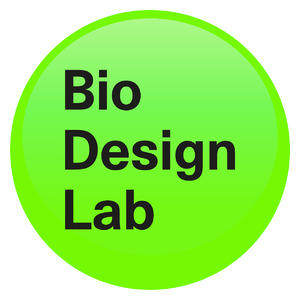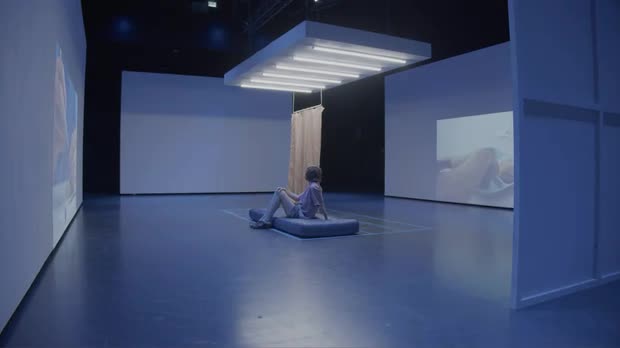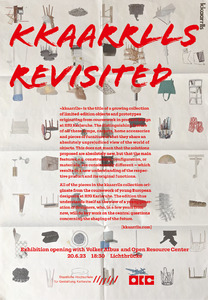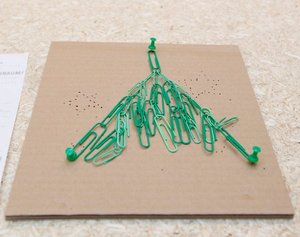Schaufenster Testing TEMP
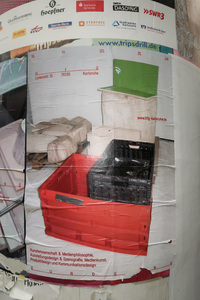
Schaufenster Testing TEMP
| Titel |
|
40 Inhalte
- Seite 1 von 4
Bio Design Lab
- Titel
- Bio Design Lab
- Beschreibung (de)
- Das Bio Design Lab ist ein hybrider und evolutiver Ort, der sowohl im digitalen als auch im physischen Raum existiert. Konzipiert als wachsende Plattform, die die Fachbereiche der Staatlichen Hochschule für Gestaltung miteinander verbindet, wird das Labor als Raum für Präsentation, Bildung und Wissensvermittlung genutzt.
Das Bio Design Lab konzentriert sich auf die lokale Region, ihre Ressourcen und Möglichkeiten und zielt aktiv darauf ab, die Produktionsweisen in Karlsruhe und Süddeutschland umzugestalten und neu zu überdenken. Zur Interaktion mit diesen Themen und Materialien, sowohl im digitalen als auch im physischen Raum, lädt das Labor lokale ExpertInnen und BesucherInnen gleichermaßen ein an gemeinsamen Projekten zu arbeiten.
Spuren dieser Aktivitäten komplementieren ein ständig wachsenden Netzwerk.Das Wissen über diese Ressourcen wird durch die Erstellung eines Know-how-Glossars und einer Materialbibliothek destilliert, durch virtuelle und physische Workshops vermittelt, sowie durch die Präsentationen herausragender Projekte, die sich mit nachhaltigen Materialien befassen, kommuniziert.
Das Labor fungiert als Inkubator und Modell für Zusammenarbeit und Produktion, das im Einklang mit dem aktuellen Wandel der Staatlichen Hochschule für Gestaltung Karlsruhe steht.
- Das Bio Design Lab ist ein hybrider und evolutiver Ort, der sowohl im digitalen als auch im physischen Raum existiert. Konzipiert als wachsende Plattform, die die Fachbereiche der Staatlichen Hochschule für Gestaltung miteinander verbindet, wird das Labor als Raum für Präsentation, Bildung und Wissensvermittlung genutzt.
- Beschreibung (en)
- The Bio Design Lab is a hybrid and evolutive environment that exists in both the digital and physical space. Conceived as a platform for connection and collaboration with local partners and using local resources, the Lab hosts the presentation, education and transmission of knowledge. As students and experts are invited to work on bio-design related projects, visitors can explore and interact with the Lab’s production and lines of inquiry.
Projects within the Lab focus on the local region, its materials and possibilities, and actively aim to reshuffle and rethink modes of production in Karlsruhe and the south of Germany. Topics under exploration include Algae, Soil, Plants, Body, and Agriculture. To interact with these themes and related materials, both within the digital and physical space, the Lab invites local experts and visitors alike.
Within the Bio Design Lab, regional resources are collected by connecting with local partners; they are then distilled through the making of a know-how glossary and a material library, aiming to develop local materials. The knowledge around these resources is disseminated through virtual workshops and multimedia presentations of outstanding projects dealing with sustainable materials. Ultimately, traces of these activities will remain in a constantly growing network, both in the digital platform and in physical displays of existing and future objects.
The Lab works as an incubator and a model for collaboration and production that is in line with the current transformation of the Karlsruhe University of the Arts and Design Karlsruhe. It was first presented to the public in the context of Critical Zones, an exhibition at ZKM | Center for Art and Media.
- The Bio Design Lab is a hybrid and evolutive environment that exists in both the digital and physical space. Conceived as a platform for connection and collaboration with local partners and using local resources, the Lab hosts the presentation, education and transmission of knowledge. As students and experts are invited to work on bio-design related projects, visitors can explore and interact with the Lab’s production and lines of inquiry.
- Schlagworte
- Ort: Institution
- Ort
- Bio Design Lab
- Stadt
- Land
- Internetlinks
- Titel
- Bio Design Lab
- Projektleiter/in
- Importiert am
- 23.10.2023
- Übergeordnete Sets
- 1
- Set enthält
- 1 2
7QM
- Titel
- 7QM
- Titel (en)
- 7sqm - inside views
- Untertitel
- Innen(an)sichten
- Autor/in
- Beschreibung (de)
- Was passiert, wenn Individuen in engen, geschlossenen Räumen mit kaum persönlicher, sondern standardisierter, fest verankerter, textilloser Ausstattung leben, in denen sie einer permanenten Überwachung und Kontrolle sowie streng geregelten Tagesabläufen ausgesetzt sind?
Mascha Dilger untersucht die Parameter sanktionierender Räume: Besuche in unterschiedlichen Justizvollzugsanstalten und Interviews mit ehemaligen Inhaftierten werden in der Rauminstallation 7qm - Innen(an)sichten verarbeitet. Realitäten eines vor der Gesellschaft verborgenen und von ihr verdrängten Ortes werden offengelegt.
Die Arbeit beleuchtet, wie aus einem fremdbestimmten, rasterartigen Alltag einer totalen Institution, Versuche der geistigen Flucht und der Selbstbestimmtheit hervorgehen können. Es werden ortsspezifische und subkulturelle Erscheinungsformen betrachtet, die als Überlebensstrategien zu verstehen sind.
- Was passiert, wenn Individuen in engen, geschlossenen Räumen mit kaum persönlicher, sondern standardisierter, fest verankerter, textilloser Ausstattung leben, in denen sie einer permanenten Überwachung und Kontrolle sowie streng geregelten Tagesabläufen ausgesetzt sind?
- Beschreibung (en)
- What happens when individuals live in narrow, confined spaces with hardly any personal but standardized, firmly anchored, textile-less furnishings, in which they are exposed to permanent surveillance and control as well as strictly regulated daily routines?
Mascha Dilger investigates the parameters of sanctioning spaces: visits to various prisons and interviews with former inmates are processed in the spatial installation "7qm - Innen(an)sichten". Realities of a place hidden from society are revealed.
The work illuminates how attempts of mental escape and self-determination can emerge from the grid-like everyday life of a total institution. Site-specific and subcultural manifestations are considered, which are to be understood as survival strategies.
- What happens when individuals live in narrow, confined spaces with hardly any personal but standardized, firmly anchored, textile-less furnishings, in which they are exposed to permanent surveillance and control as well as strictly regulated daily routines?
- Kategorie
- Typ des Projekts/Werks
- Schlagworte
- Datierung
- 11.07.2023 - 12.07.2023
- Mitwirkende
- Dank an
- Zaur Ahlimanov
- Phillip Banian
- Jeremias Beckford
- Sandra Blatterer
- Barbara Bohnen
- Matthias Bruhn
- Richard Brunner
- Céline Condorelli
- Hannah Cooke
- Jaya Demmer
- Lina Determann
- Nicola Dilger
- Susanne Dilger
- Alfred Dilger
- Manfred Döpke
- Nina Eberle
- Kerstin Eisenmenger
- Constanze Fischbeck
- Ebba Fransén Waldhör
- Laura Haak
- Uwe Habel
- Laurine Haller
- Igor Hardt
- Lina Höhne
- Lovis Iglinski
- Martina Kaltenbrunner
- Tobias Keilbach
- Alexander Knoppik
- Katja Koch
- Mikail Kolbasar
- Hanne König
- Susanne Kriemann
- Claudia Kröhl
- Barbara Kuon
- Alexia Metge
- Paulina Mimberg
- Ilja Morgenstern
- Leonie Mühlen
- Minh Anh Nguyen
- Luise Peschko
- Vlado Petrovic
- Milena Petrovic
- Tibor Pilz
- Christian Platz
- Paul Platz
- Waldemar Präg
- Corinne Riepert
- Thomas Rustemeyer
- Sebastian Schäfer
- Max Schäffer
- Philipp Schell
- Susanne Schmitt
- Mischa Schneider
- Waldemar Schwab
- Henriette Schwabe
- Manuel Sékou
- Alexander Theis
- Alexander Thelen
- Jan Tölle
- Lisa Tölle
- Lioudmila Voropai
- AStA
- Exit - Enter Life e.V.
- Badaue
- JVA Mannheim
- JVA Bühl
- Initiative „Faites Votre Jeu!“
- Sprache
- Material
- Ort: Institution
- Ort
- im großen Studio
- Stadt
- Land
- Beteiligte Institution(en)
- Titel
- 7QM
- Projektleiter/in
- Semester
- Studiengang
- Typ der Abschlussarbeit
- Importiert am
- 26.07.2023
- Übergeordnete Sets
- 3
- Set enthält
- 4 2
kkaarrlls revisited
- Titel
- kkaarrlls revisited
- Autor/in
- Beschreibung (de)
- Das HfG OPEN RESOURCE CENTER lädt Sie herzlich ein zur Eröffnung der Ausstellung kkaarrlls Revisited
Dienstag
20. Juni
18:30
Lichtbrücke
Volker Albus, einer der dienstältesten Professoren des Fachbereichs Produktdesign und ehemaliger Prorektor der HfG, eröffnet die Ausstellung ausgewählter Objekte der Designmarke kkaarrlls, die von HfG-Studierenden entworfen und entwickelt wurden.
kkaarrlls ist ein Projekt, das innerhalb des Fachbereichs PD initiiert wurde und sich zu einer hauseigenen Marke der HFG Design entwickelt hat. Sie repräsentiert eine erlesene Auswahl an Arbeiten von PD-Studierenden aus dem Zeitraum von 2009 bis 2017.
kkaarrlls wurde regelmäßig auf dem Salone Internazionale del Mobile in Mailand präsentiert und hat internationale Aufmerksamkeit in Zeitungen wie Le Monde oder New York Times erlangt.
- Das HfG OPEN RESOURCE CENTER lädt Sie herzlich ein zur Eröffnung der Ausstellung kkaarrlls Revisited
- Beschreibung (en)
- The HfG OPEN RESOURCE CENTER cordially invites you to the opening of the kkaarrlls Revisited exhibition
Tuesday
20th of June
18:30
Lichtbrücke
Volker Albus, one of the longest serving professors of the Product Design department and former HfG prorektor, will open the exhibition of selected items of the kkaarrlls design brand, created and developed by HfG students.
kkaarrlls is a project initiated inside the PD department and has evolved into an in-house brand of HFG design, representing a distinguished selection of PD student's works from the period of 2009 to 2017.
kkaarrlls has been perdiodically presented at the salone internazionale del mobile in Milan and has gained international attention in newspapers like Le Monde or New York Times.
- The HfG OPEN RESOURCE CENTER cordially invites you to the opening of the kkaarrlls Revisited exhibition
- Typ des Projekts/Werks
- Schlagworte
- Datierung
- 20.06.2023
- Ort: Institution
- Ort
- Lichthof 3
- Stadt
- Land
- Internetlinks
- Titel
- kkaarrlls revisited
- Importiert am
- 26.07.2023
- Übergeordnete Sets
- 2
- Set enthält
- 0 5
Oh Tannenbaum!
- Titel
- Oh Tannenbaum!
- Titel (en)
- Oh Tannenbaum!
- Untertitel
- Designers Christmas Trees
- Beschreibung (de)
- Die Ausstellung »Oh Tannenbaum« spielt mit dem Symbol, dem allgemeinen Bild des Weihnachtsbaumes: Sie zeigt Exponate, die sich teils weit entfernt von der gängigen Vorstellung des Tannenbaums befinden und doch immer auf unterschiedlichste Art auf sie verweisen.
Der Titel der Ausstellung drückt in seiner Schreibweise sowohl die be- bis entgeisterte Betrachtung der Exponate als auch die be- bis entgeisterte gestalterische Annäherung an das Thema aus. Ob begeisternd, bestürzend oder belächelt – jedes einzelne Exponat zeugt von einem ganz eigenen Bild des jeweiligen Gestalters vom Weihnachtsbaum, das mal mehr, mal weniger mit dem allgemeinen Bild des Weihnachtsbaums korrespondiert.
Kaum ein anderes Objekt bietet hier so viel Spielraum, zeigt so viel Potential: Das Nebeneinander des einerseits so Speziellen, des eindeutigen und verbreiteten Bilds – ein in grüne Nadeln, (rote) Kugeln und (weiße) Kerzen gewandeter Kegel – und des andererseits so viel Allgemeines implizierenden Symbols macht den Weihnachtsbaum zu einem solch besonderen Objekt.
Er ist heidnisch und christlich, er steht im Super- und auf dem Weihnachtsmarkt, steht für Fruchtbarkeit und Kommerz, im Wohnzimmer und auf dem Marktplatz – in Stockholm und Kapstadt, Miami und Peking – und bietet aus verschiedensten Positionen und Blickwinkeln entsprechend unterschiedliche Gesichter.
Dass dieser Baum in all den religiösen, profankulturellen, kommerziellen, formalen, historischen, familiären, sozialen und sonstigen Böden Wurzeln schlagen konnte und aus all diesen doch zu einer so eindeutigen und unverwechselbar immergrünen Ikone wuchs, scheint den Gestaltern so viele Ansatzpunkte zu Idealisierung, Ironisierung, Kritik, Collage, Persiflage, Hinterfragung, Überzeichnung, Verballhornung oder sonstiger Gestaltung zu bieten.
Vielleicht entlocken Ihnen die Motive ja auch ein entzücktes "Oh Ja!", das ein oder andere "Oh je" und vielleicht auch so manches "Oh nein!"...
Fröhliches Betrachten!
Johannes Marmon & Johannes Müller
- Die Ausstellung »Oh Tannenbaum« spielt mit dem Symbol, dem allgemeinen Bild des Weihnachtsbaumes: Sie zeigt Exponate, die sich teils weit entfernt von der gängigen Vorstellung des Tannenbaums befinden und doch immer auf unterschiedlichste Art auf sie verweisen.
- Beschreibung (en)
- The exhibition »Oh Tannenbaum« plays with the iconic symbol of the Christmas tree. Although some of the contributions are far removed from the popular notion of what this tree looks like, each refers to the traditional image in its own way.
The unusual spelling in the title of the exhibition – “Oh” rather than the conventional “O” Tannenbaum – is intended to convey both the range of possible reactions to the works on show – from enthusiastic approval to bemused consternation – and the equally diverse creative approaches to the chosen theme. Whether it elicits a smile of amusement, an appreciative nod or a shocked gasp, each exhibit reflects its creator’s personal vision of the Christmas tree, which may or may not correspond to the standard image of this object.
Few other objects offer as much scope for interpretation or have such evocative potential as the Christmas tree. The combination of the specific and the universal is what makes it so unique – on the one hand there is the classic image of a cone-shaped object clad in green needles, (red) baubles and (white) candles, and on the other is the widespread recognition and value of this symbol.
The Christmas tree is both pagan and Christian; it can be found in supermarkets and at winter fairs; it represents fertility and commerce; it is put on display in living rooms and on public squares from Stockholm to Cape Town, Miami to Beijing – and takes on a new appearance from every different angle.
The fact that this tree has put down roots in all these different religious, secular, commercial, formal, historical, familial, social and other traditions, yet has still managed to grow into such an unmistakable evergreen icon, provides many valuable starting points for idealizing, ironic, critical, collaged, satirical, challenging, exaggerating, parodying and other individual forms of interpretation.
Now all that remains to be seen is which interpretations among those presented here will make you respond with a delighted “Oh yes!”, the occasional “Oh dear” and even the odd “Oh no!”...
Happy viewing!
Johannes Marmon & Johannes Müller
- The exhibition »Oh Tannenbaum« plays with the iconic symbol of the Christmas tree. Although some of the contributions are far removed from the popular notion of what this tree looks like, each refers to the traditional image in its own way.
- Typ des Projekts/Werks
- Datierung
- 2004 / 2013
- Ort
- Hochschule für Gestaltung
- Stadt
- Land
- Internetlinks
- Titel
- Oh Tannenbaum!
- Importiert am
- 03.07.2018
- Übergeordnete Sets
- 2
- Set enthält
- 0 45
